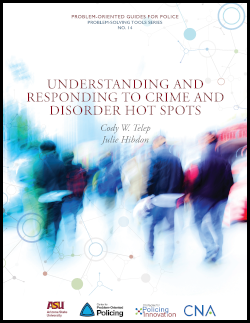
In 2013, the Bureau of Justice Assistance (BJA) funded CNA to work with the Center for Problem-Oriented Policing to develop a series of Smart Policing Initiative (SPI) Problem-Oriented Guides for Police. The purpose of these guides is to provide the law enforcement community with useful guidance, knowledge, and best practices related to key problem-oriented policing, and Smart Policing principles and practices. These guides add to the existing collection of Problem-Oriented Guides for Police.
This guide highlights hot spots policing, which is sometimes referred to as place-based policing. It is highly compatible with problem-oriented policing (POP) and the scanning, analysis, response, and assessment (SARA) model. A number of hot spot policing interventions have used the SARA model to guide analysis and develop appropriate responses. Herman Goldstein introduced this link between place and addressing problems in his original formulation of POP. He described incidents concentrating in a particular area as one of the most common ways to characterize a problem. This guide uses the SARA model as a framework to discuss the process of understanding and responding to hot spots.
The policing models Compstat and predictive policing also have features in common with problem-oriented policing, but also some differences. The main common feature is the use of geographic mapping to direct and prioritize police attention. However, to the extent that Compstat and predictive policing limit the police response to something like saturation patrol or an enforcement crackdown, they are distinguishable from problem-oriented policing. Conversely, to the extent that they use the initial geographic analysis as a starting point to a deeper analysis of the problems at identified locations, and to the development and implementation of a tailored response to each problem location, these models are consistent with problem-oriented policing.
The first section of this guide focuses on defining what hot spots are, discussing why they are important, and using theory to understand the kinds of locations that are likely to exhibit high activity. These are important first steps in the scanning phase of hot spot identification.
The second section emphasizes the scanning phase of the SARA model. The scanning phase is completed by using data to identify or confirm the highest crime and disorder locations.
The third section focuses on hot spot analysis. The goal of the analysis phase is to conduct an in-depth examination of police incidents and other data sources to better understand why incidents are clustered at that location. This analysis helps to develop an appropriate response tailored to the underlying contributors to the problem at each location.
The fourth section covers the response phase in the SARA model. This section reviews effective responses to hot spots used in prior interventions, based on rigorous research evidence.
The final section on assessment discusses the results of prior reviews of the hot spot policing literature and provides advice for agencies considering hot spot policing. Assessment should focus on the implementation of the intervention (process evaluation), whether overall crime (or calls, automobile crashes, or other problems) decreased in the targeted locations, and whether the specific problems identified in the analysis phase were successfully addressed (outcome evaluation).
